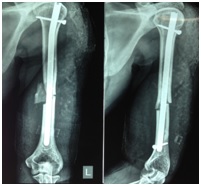Comparative study of radiological and clinical outcomes by using single and double interlocking distal screws for humerusshaft fractures
Abstract
Background: The aim of this study was to make a comparative analysis of radiological and clinical outcomes of using either one or two interlocking distal screws on ahumerus intramedullary nail for the internal fixation of humeral shaft fractures.
Methods: From April 2010 to April 2015, 30 patients were enrolled with humeral shaft fractures who were operated on using intra medullary humerus nails. The patients were divided into 2 groups according to how many interlocking distal screws were used to lock the humerus nail: in group 1, a single interlocking distal screw was used in 16 patients; and in group 2, double interlocking distal screws, in 14 patients. We compared the degree of recovery of the displaced fracture fragments between the two groups. Shoulder function of patients wereassessed by modified American Shoulder and Elbow Surgeons (ASES) score.
Results: We found that 15 (93.7%) fractures achieved union in group 1, and 13 (92.8%) of fractures, in group 2. There was no meaningful difference in the time to bone union and the recovery of displaced fracture fragments between the two groups. At the final follow-up, we found that the scores for shoulder joint modified ASES was 76.2 for group 1 and 79. 1 for group 2.
Conclusions: This study shows that if locked appropriately, even a single screw on a humerusnail can provide satisfactory radiological union and improved clinical outcome after intramedullary nailing of humeral shaft fractures.
Downloads
References
2. Sarmiento A, Waddell JP, Latta LL. Diaphyseal humeral fractures: treatment options. Instr Course Lect. 2002;51:257-69.[pubmed]
3. Nam TS, Choi JW, Kim JH, Kim SY, Kim JJ, Chun JM. Nonunion of the humerus shaft. J Korean Fract Soc. 2005;18(3):294-8.
4. Lee HJ, Oh CW. Operative treatment of humerus shaft fracture: conventional open plating or minimally invasive plate osteosynthesis. J Korean Fract Soc. 2012;25(2):155-62.
5. Meekers FS, Broos PL. Operative treatment of humeral shaft fractures. The Leuven experience. Acta Orthop Belg.2002;68(5):462-70. https://doi.org/10.12671/jkfs.2012.25.2.155.[pubmed]
6. Chen F, Wang Z, Bhattacharyya T. Outcomes of nails versus plates for humeral shaft fractures: a Medicare cohort study. J Orthop Trauma.2013;27(2):68-72.[pubmed]
7. Chen AL, Joseph TN, Wolinksy PR, et al. Fixation stability of comminuted humeral shaft fractures: locked intramedullary nailing versus plate fixation. J Trauma. 2002;53(4):733-7.[pubmed]
8. Levin PE, Schoen RW Jr, Browner BD. Radiation exposure to the surgeon during closed interlocking intramedullary nailing. J Bone Joint Surg Am.1987;69(5):761-6.[pubmed]
9. Yang KH. Helical plate fixation for treatment of comminuted fractures of the proximal and middle one-third of the humerus. Injury. 2005;36(1):75-80.[pubmed]
10. Riemer BL, Butterfield SL, D’Ambrosia R, Kellam J. Seidel intramedullary nailing of humeral diaphyseal fractures: a preliminary report. Orthopedics.1991;14(3):239-46.[pubmed]
11. Spiguel AR, Steffner RJ. Humeral shaft fractures. Curr Rev Musculoskelet Med. 2012;5(3):177-83.[pubmed]
12. Garnavos C, Lasanianos N. Intramedullary nailing of combined/ extended fractures of the humeral head and shaft. J Orthop Trauma.2010;24(4):199-206.[pubmed]
13. Lin J, Hou SM. Locked nailing of severely comminuted or segmental humeral fractures. Clin OrthopRelat Res.2003;406: 195-204.[pubmed]
14. Brumback RJ, Bosse MJ, Poka A, Burgess AR. Intramedullary stabilization of humeral shaft fractures in patients with multiple trauma. J Bone Joint Surg Am.1986;68(7):960-70.[pubmed]
15. Lin J. Treatment of humeral shaft fractures with humeral locked nail and comparison with plate fixation. J Trauma.1998;44(5): 859-64.[pubmed]
16. Hall RF Jr. Closed intramedullary fixation of humeral shaft fractures. Instr Course Lect.1987;36:349-58.[pubmed]
17. Park JY, Oh JH, Kho DH, Jung JK. Intramedullary nail on the humeral fracture. J Korean Fract Soc. 2008;21(3):244-54.http://dx.doi.org/10.5397/cise.2015.18.2.91
18. Choy WS, Park YB, Park JH, Ann TG, Ahn JS, Choi SW. Torsional characteristics between single and double distal screws in the interlocking intramedullary nailing of humeral shaft fracture. J Korean Orthop Res Soc. 1999;2(2):111-6.
19. Carter DR, Beaupré GS, Giori NJ, Helms JA. Mechanobiology of skeletal regeneration. Clin OrthopRelat Res. 1998;(355 Suppl):S41-5.[pubmed]



 OAI - Open Archives Initiative
OAI - Open Archives Initiative


















 Therapoid
Therapoid

